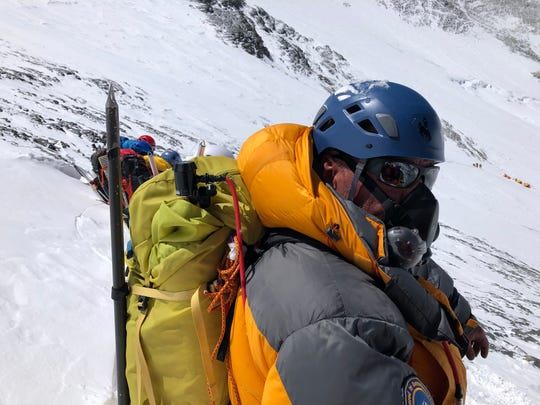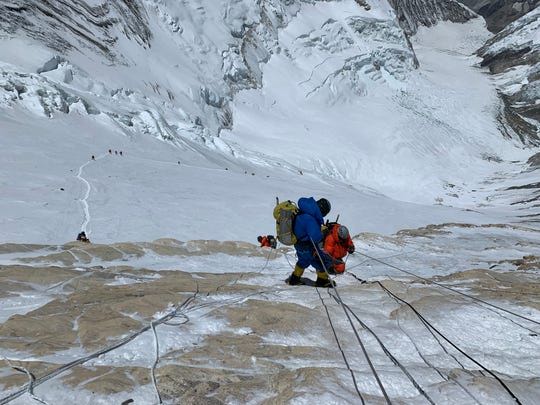Mount Everest summit was within sight.
Why did University of Cincinnati grad stop?
The following article was published on June 16, 2019, via the Cincinnati Enquirer (www.cincinnati.com). It was reprinted with permission from Sheila Vilvens, the author of the article, which highlights Matt Brennan (Beta Omicron/Cincinnati 1984).
This wasn’t the first time University of Cincinnati graduate and Fairfield businessman Matt Brennan encountered a dead body on a mountain.
It was, however, his first brush with a recently deceased climber.
The encounter came as Brennan, 58, made his way from Camp 3 to Camp 4, known as the South Col, on Mount Everest. It wasn’t the last body he would see during his climb.

Eleven people died during the 2019 climbing season on Mount Everest, the most since 2015. Brennan encountered four of the recently deceased.
An experienced climber, Brennan hoped to summit Everest. It was his second attempt in as many years.
He came close. The summit was within sight, about 1,000 feet away, but still proved elusive.
Mount Everest traffic jam
Circumstances seemingly conspired against the local adventurer. The climb to Camp 4 took longer than expected, zapping Brennan's energy. A much-needed rest day was eliminated when a forecasted storm forced summit day to be moved from May 24 to May 23. Then there was the line.
At midnight Brennan and his team made their final push for the summit. Ahead of them, they could see a steady line of climbers, their silhouettes illuminated by headlamps. The mountain was crowded. The congestion worsened as night turned to day and ascending and descending climbers met.
Eight hours after leaving Camp 4, Brennan and his team should have been about one hour from the summit. That wasn’t the case. The team was still four to five hours from the top of the world.
The difficult choice
Despite the long delays, cramping in his legs, and the loss of a spare oxygen tank, Brennan remained confident that he could summit the mountain, he said Tuesday from his home in Miami Township, near Loveland. However, he was uncertain he could safely return.
"It’s one thing to get to the top, but it's another thing trying to get down to your tent," Brennan said. "That’s where people die. They don’t die from falling. They don’t die from getting to the top or some rock hits them in the head. People die on that mountain from exhaustion.
"They sit down because they’re exhausted, to rest and relax and they run out of oxygen and they never get up again. It’s not a violent death. It’s a very peaceful death."
With a wife, children and a business, not making it safely back down Everest was not an option, he said.
After several moments of honest self-reflection, Brennan said he made the difficult decision to end his push for the summit.
“I was within 1,000 feet of the top of the world. I spent 60 days in a tent. I’d spent tens of thousands of dollars. I’ve trained. I had all these people supporting me. It was defeating,” he said about that moment and the decision.
The factors of weather, lines, and age were all against him, he said.
“When I stacked all that together, I said to myself, ‘You know what, I’m not going to risk it.’ It wasn’t worth the risk. And it hurt to make the decision. Because everybody on the team summited but they summited outside all the rules,” Brennan said.
Brennan's wife: supportive but . . .
Back home his wife, Susan, and daughter Madeline, 20, were in bed anxiously watching Brennan’s Garmin signal tracking his progress in the mountain’s death zone. Her sons from a previous marriage were watching and texting. The couple’s youngest son, Blake, 19, who is severely autistic, rested.
They saw his signal make a turn and go back down the mountain. They had no idea why.
Susan Brennan is not the kind of person who enjoys public attention. In fact, she avoids it. However, she is a strong supporter of her husband’s adventures.
“Of course, I’m rooting for him,” she said. “I want it for him more than anything in the world. Do I like him going? No. But for him, I want him to be successful.”

He’s been climbing since Madeline and Blake were babies. Madeline has been on climbs with her father.
Brennan has successfully summited dozens of mountains. He's summited the highest mountains on five continents. His goal is to reach seven. Susan Brennan has been supportive throughout and recalls only one concerning episode over the years on Mount Rainier.
It was his first big climb, she recalled. The mountaineering company he used called to say there had been an accident but that Matt was OK, she said. However, he was tethered to the side of the mountain as a helicopter attempted a rescue.
“They called to say if you’re watching CNN, you’re going to see this and we wanted you to know Matt’s OK. My heart did stop on that one. But that was the first one,” Susan Brennan said. “Since that, I’ve been through a lot. And I know he knows his limitations, and he’s not going to do anything on purpose that is going to cause him harm. I mean, there are always accidents."
Mount Everest 2019: Long lines and trash notable
A lot has been said over the years about Mount Everest, the trash and dead bodies, and this climbing season, Brennan said. Much of it is wrong. He wants to set the record straight.
The long lines in the 2019 climbing season: It was not a permit problem, a typical number was issued by the Nepalese government, but a weather problem that contributed to the long lines seen in photographs, he said.
Trash on the mountain: It’s not as bad as it’s portrayed, Brennan said. Camp 1 and Camp 3 are clean. There’s a little garbage at Camp 2. Camp 4 has a trash problem, he said. They’re having problems getting people who will go up there and haul trash from the death zone.
Dead bodies: There are a couple of dead bodies up there that, for one reason or another, can not be removed, Brennan said. Most, however, are recovered and brought back down the mountain.
Will there be a third attempt?
The decision to abort his climb short of the summit wasn't the hardest decision of Brennan's life. It was the most emotional.
"I was lucky that I still had my faculties enough, that I wasn't too high into it that I wasn't thinking," he said.
That wasn't the case for one climber he encountered. Brennan said people told her to turn around before it was too late. She didn't listen and died on the mountain.
While disappointed in the way things turned out, Brennan identified his decision to end his summit day early as the most enriching part of his journey.
"I had the ability to make the tough decision when I needed to," he said.
He's working with his trainer to understand what caused his body to slow down on the climb to Camp 4. He's also considering his options.
When he first returned from Nepal, he told his wife he was done with the big mountains. Now, he's not so certain. He might go back to Everest, he said, but under different circumstances.
While he's disappointed, his wife said his family and friends are celebrating his success and return.
You may view the original article by clicking here.



